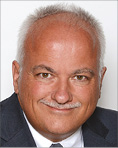
If you had to highlight one milestone in the history of interventional cardiology, which one would you choose and why?
It would be successfully putting stents on a catheter for use in human coronary arteries, making Grüntzig’s balloon angioplasty more safe and effective.
Which one of the pioneers of our specialty has most influenced your practice and why?
My teacher and mentor Raimund Erbel. He taught me, motivating me to choose the speciality of interventional cardiology, and offered me the opportunity to gain expertise and skills. At the same time, he encouraged a strong scientific approach, a necessary element in further developing and improving interventional techniques.
This year the ESC Congress and the EAPCI are celebrating 40 years of PCI: what’s not to be missed in Barcelona?
Clearly the exhibition on the “40 years of Angioplasty PCR/EAPCI Expo @ ESC 2017”, already shown during EAPCI’s main congress, EuroPCR 2017, in Paris.
What does it mean for you personally to celebrate the 40 years of angioplasty/PCI this year?
This celebration provides us with the opportunity to undertake an exciting review of the ground-breaking technological developments which have significantly impacted on patient treatments and outcomes over these last decades. For me, personally, for 30 years it has been an exciting and integral part of my professional life.
What are the challenges facing interventional cardiology today?
Looking specifically at coronary interventions, probably the next iterative step will be the successful development of fully bioresorbable scaffolds to allow vascular restoration. Initially, this technology created an enormous amount of enthusiasm; currently it is being critically re-assessed due to disappointing results for some of the first-generation devices. Further developments are needed and this will drive our attempts to improve the results of this technology. Concerning valvular and structural heart disease, catheter-based technologies with the least invasive approach will be further developed, similar to what we have successfully achieved with TAVI for aortic stenosis.
What unmet needs remain to be answered or what advances need to occur in the next 40 years of our specialty?
We need to move coronary interventional cardiology from a focal treatment strategy of coronary artery stenosis to a broader treatment of the underlying atherosclerotic process itself.
| NEWS ■ The new EAPCI mission statement is now aligned to the ESC mission: “To reduce the burden of cardiovascular disease through percutaneous cardiovascular interventions”. ■ EAPCI @ ESC Congress in Barcelona for the 40 years of PCI! ESC Congress (26-30 August 2017) is here: come and visit us on ESC Plaza to learn more about EAPCI activities during the congress and about ongoing projects! ■ EAPCI Certification demonstration at ESC Congress 2017: the EAPCI is aiming to launch an individual certification in interventional cardiology in May 2018. Find out more about this new initiative on Saturday 27 August from 17:00 - 18:00, ESC Meeting Room 01 - Level 1. ■ Don’t miss the EAPCI webinar! Register for the next EAPCI live event to be held on 8 September from 18:00 to 19:00 CEST with Profs Julinda Mehilli, Jurrien Ten Berg and Michael Haude: “Focus on antithrombotic treatment of patients under oral anticoagulation in need of PCI – from randomised clinical trials to the individual patient”. ■ Remember! For all EAPCI activities go to: |

